Pioneering materials science
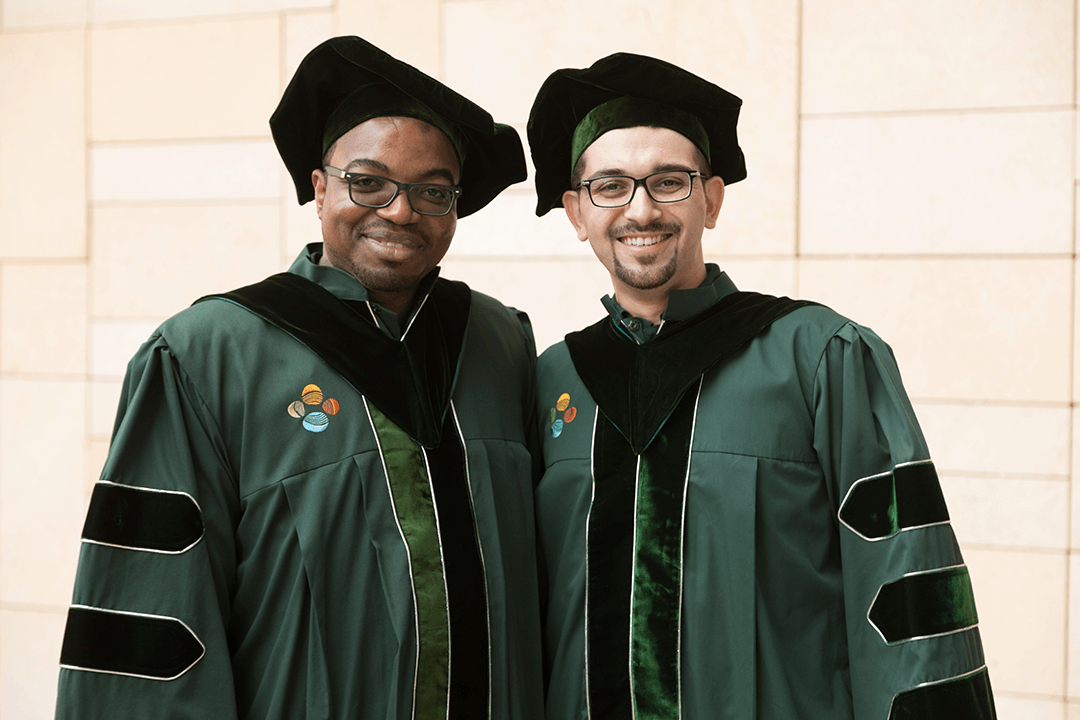
KAUST graduates Guy Olivier Ngongang Ndjawa (Ph.D. '16) (left) and Ahmed Mansour (Ph.D. '16) cite their experience as members of the University's MRS student chapter as an important part of their student careers. Photo by Helmy Al Sagaff.
For 12 KAUST students and postdoctoral fellows and 11 University faculty members, the 2017 Materials Research Society (MRS) Spring Meeting & Exhibit in Phoenix, Arizona, U.S., held from April 17 to 21, proved an outstanding venue to learn more about key materials science topics, network with other researchers and students and spend some time out of the lab.
MRS holds two major meetings per year in the spring and the fall, convening materials science researchers and experts from around the world to share their work and learn about career opportunities. KAUST students, postdocs and faculty members often take part in these meetings, bringing their unique perspectives and experience to the events.
KAUST students and MRS
(From left to right): Ahmed Mansour (Ph.D. '16), KAUST Professor Husam Alshareef, Ph.D. student Rahim Munir and Guy Olivier Ngongang Ndjawa (Ph.D. '16) set up the Student-Organized Events, a series of seminars and workshops on publishing and writing skills, at the 2016 MRS Fall Meeting & Exhibit in Boston, Massachusetts, as part of their work with the KAUST MRS student chapter. Photo by Nicholas Demille.
KAUST student participation was a special part of the 2016 MRS Fall Meeting & Exhibit in Boston, Massachusetts, during which KAUST MRS student chapter members Ahmed Mansour (Ph.D. '16), Guy Olivier Ngongang Ndjawa (Ph.D. '16), Rahim Munir, Maha Alamoudi and Sanaa Alshammari and KAUST Professor Husam Alshareef gathered a series of experts together for the Student-Organized Events, a three-day series of seminars and workshops covering writing and publishing skills.
Munir represented the KAUST student chapter at the Spring 2017 event, attending a university chapters luncheon to recap the Fall 2016 communication seminars for attendees.
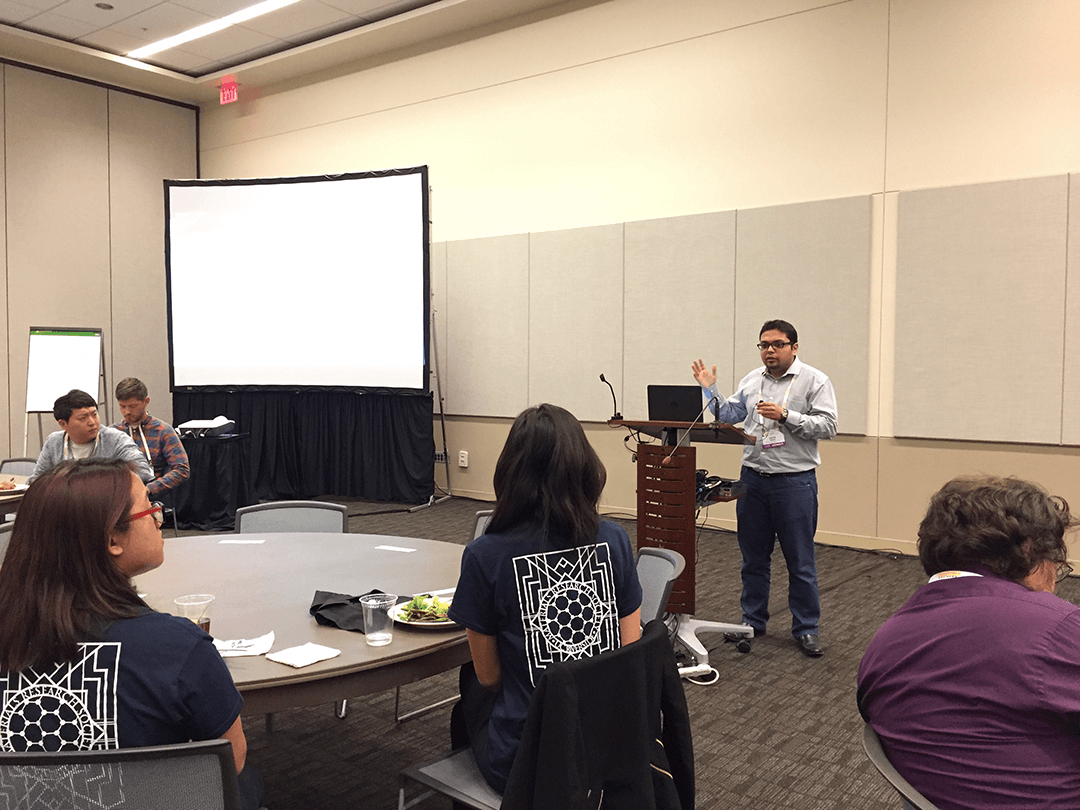
KAUST Ph.D. student Rahim Munir presents the KAUST MRS student chapter's work to an audience of MRS student chapter members from universities around the world during the MRS Spring 2017 Meeting & Exhibit. Photo by Caitlin Clark.
"After the success of our Student-Organized Events last year, I felt great to represent the KAUST MRS student chapter in Arizona to motivate other students to follow their creativity," Munir said. "I believe our work at the 2016 Fall Meeting & Exhibit spoke louder than my talk at the luncheon. Every time I represent KAUST either through my work or in an extracurricular framework, I feel honored and humble at the same time."
"Being in MRS is an experience that makes your Ph.D. more memorable," he continued. "There are many societies on campus, but the MRS student chapter keeps students in touch with science and provides an opportunity to organize external events. These opportunities are seldom available for Ph.D. students."
Science reporting
KAUST material science and engineering (MSE) Ph.D. student Ahmad Kirmani had a unique role at the Spring 2017 event—not only did he present his research work in highly efficient air-stable scalable colloidal quantum dot (CQD) solar cells fabricated in a high-humidity environment—but he also acted as a science writer and reporter for the MRS blog Meeting Scene, covering 20 research presentations from the conference.
"I've attended several other international conferences during my Ph.D. at KAUST, but the MRS conference was a different affair for me because of my science reporter role," he said. "My reports aimed to present some of the latest breakthroughs in the field of materials science to the broader materials research community, and my experience as a writer there led me to start my own blog on science writing."
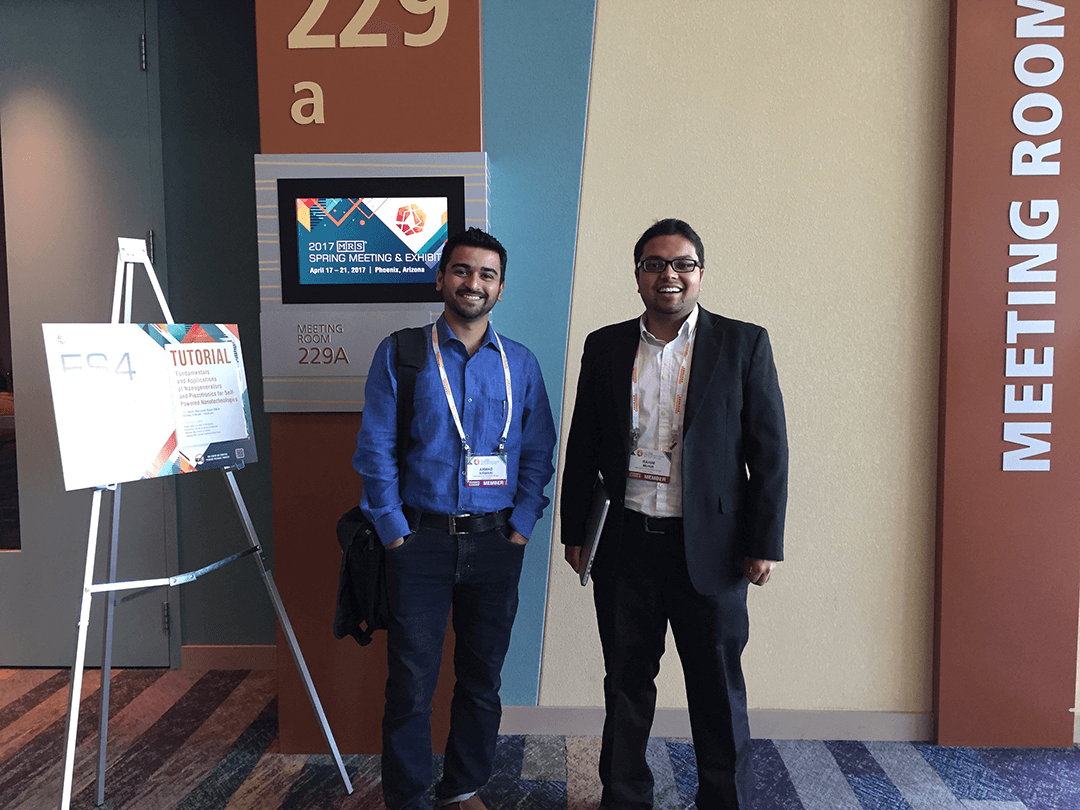
Ahmad Kirmani (left), a KAUST Ph.D. student in material science and engineering, and KAUST Ph.D. student Rahim Munir attended the 2017 MRS Spring Meeting & Exhibit in Phoenix, Arizona. Photo by Caitlin Clark.
"I feel the student chapter is the materials science face of KAUST MSE students for the world," he added. "It is important the chapter keeps going, as it gives the University's MSE students an identity at international conferences and in research activities."
Valuable career connections
The Spring 2017 event was the first MRS conference KAUST postdoctoral fellow Yuliar Firdaus attended.
"My conference talk discussed the principles that guide the selection of polymer donors for bulk heterojunction (BHJ) solar cells based on non-fullerene acceptors. The work has broader implications for further studies on the optimization of BHJ solar cell efficiencies with polymer donors and a wider range of non-fullerene acceptors," Firdaus said.
"We had good work to present, and at the Spring 2017 conference, we were able to communicate and discuss this work with the relevant communities," he noted. "This was the first time I had an oral presentation at a big international conference, so it was a valuable experience for me as part of my training as a scientist. I was also able to make career connections that will be valuable for my life after KAUST."
Networking for high-impact research
MSE Ph.D. student Ibrahim Dursun, part of the KAUST Functional Nanomaterials Lab, presented his work on using perovskite material as a color converter for simultaneous solid-state lighting and data communication at the conference.
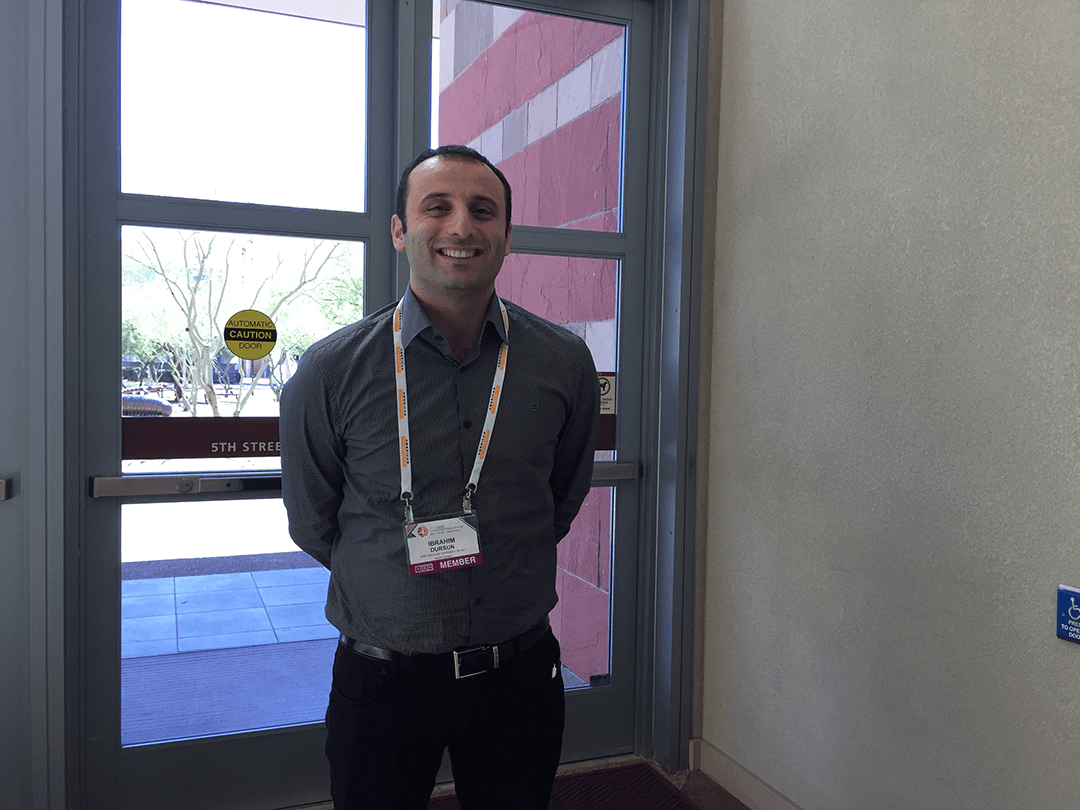
KAUST Ph.D. student Ibrahim Dursun presented his research on perovskite material at the 2017 MRS Spring Meeting & Exhibit. Photo by Caitlin Clark.
"As a team, we developed a perovskite-based visible light communication color converter that has approximately 40 times better bandwidth than commercial converters and is nearly two times better than the best alternative converter," he said. "Giving a talk on our work at such a big conference was a major motivator for my Ph.D. studies and also helped me to improve myself."
"The conference gave me the opportunity to build my professional network and get to know other students in my field," he continued. "Because there were so many people attending from all over the world, we were able to start new collaborations in our fields. The University's generous funding enabling KAUST students to attend conferences is crucial for success in our work and future careers, as collaboration and networking are prerequisites for high impact research."
A 'great environment'
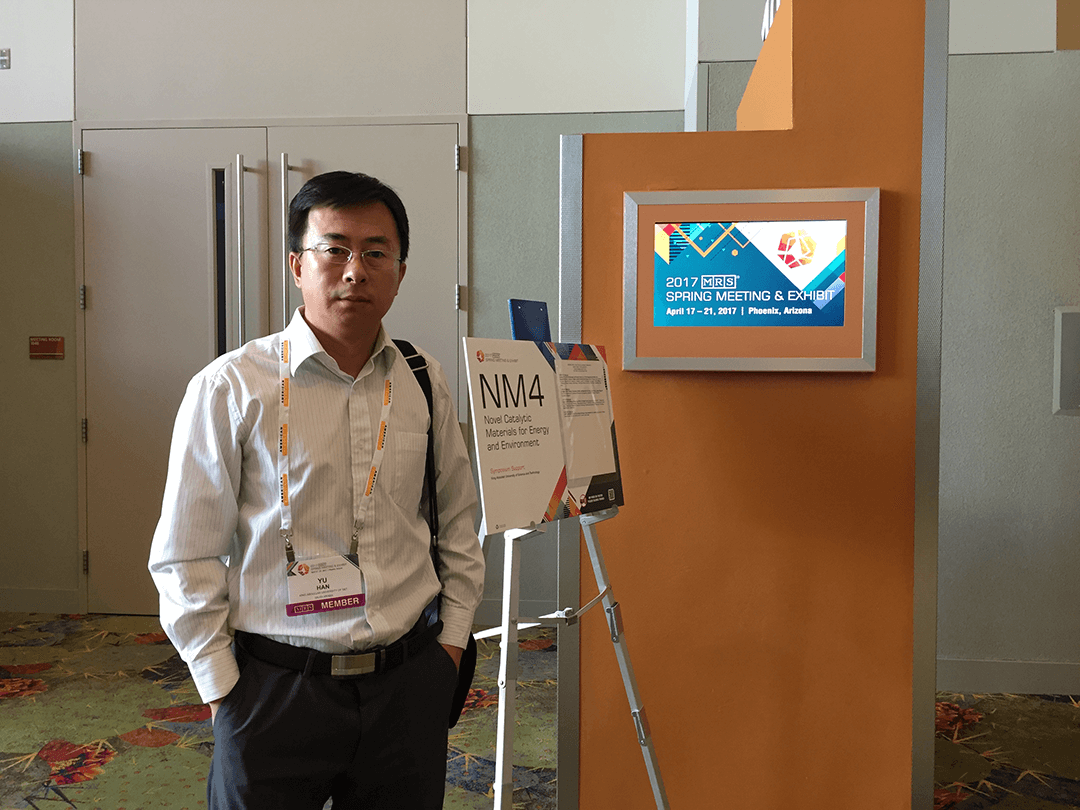
Yu Han, KAUST associate professor of chemical science, co-organized a symposium at the 2017 MRS Spring Meeting & Exhibit entitled “Novel Catalytic Materials for Energy and Environment.” Photo by Caitlin Clark.
KAUST Associate Professor of Chemical Science and conference attendee Yu Han co-organized a symposium at the event entitled "Novel Catalytic Materials for Energy and Environment," and gave a talk focusing on high resolution electron microscopy.
"MRS is the largest and the most prestigious conference for materials scientists," noted Han. "Attendees definitely benefit from it because it is a very effective platform for discussion and communication. I was impressed to see the high attendance rate at the symposium and was impressed by the quality of presentations that took place."
"The conference was a great environment this year," echoed KAUST Assistant Professor of Bioscience - Sahika Inal. "Every year at the MRS conferences we get to learn about recent research activities and discuss a variety of topics with colleagues from around the world. This tradition continued in Arizona."
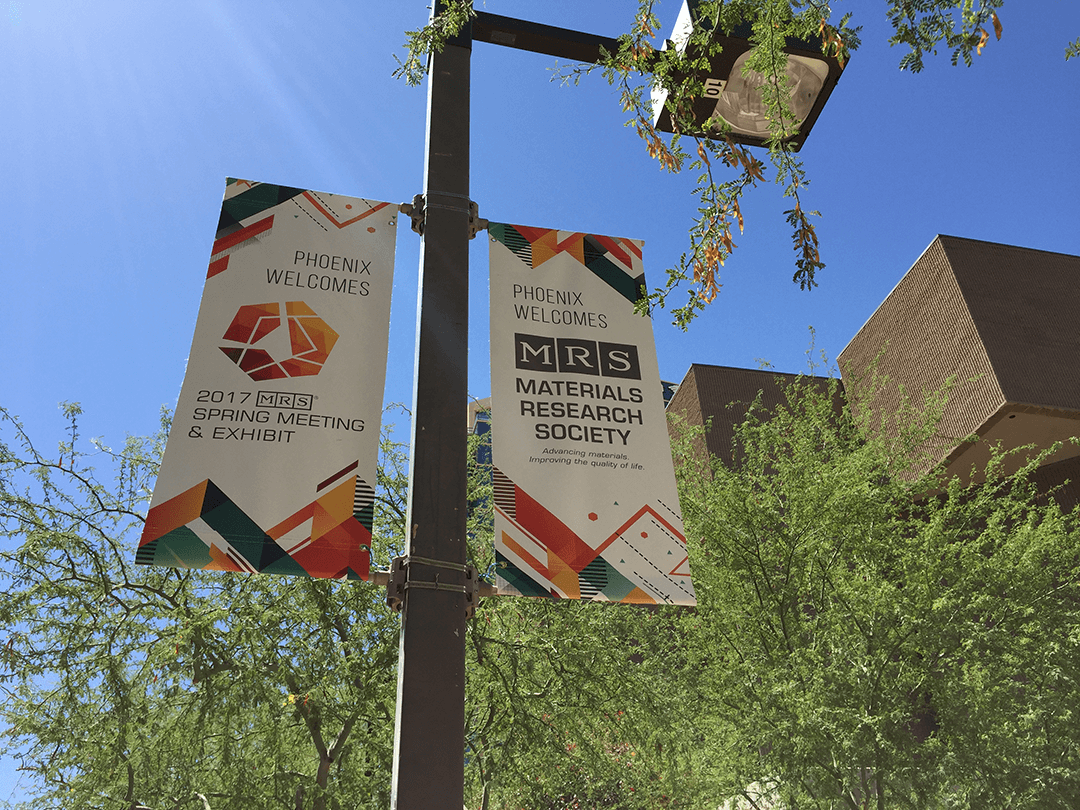
The MRS Spring 2017 Meeting & Exhibit in Phoenix, Arizona, drew materials science experts together from around the world to discuss advances in their fields. Photo by Caitlin Clark.
Inal presented her recently published work in bioelectronics—and specifically in conducting polymer scaffolds that can electrically communicate with mammalian cells—at the event.
"The scaffolds host cells and allow them to live in a 3-D physiologically relevant environment. Since they are electrically conducting, they can also pick up signals from the cells and convert these into an electrical output. This enables us to learn how the cells are doing within a tissue-like structure without destroying the tissue. The same scaffolds can also electrically stimulate the cells, and as such we can change the adhesion behavior of cells," she explained.
Leaders in materials science
KAUST Associate Professor of Chemical Science and conference speaker Kazuhiro Takanabe gave two invited talks at the event, "giving better visibility to both me and to KAUST," he noted. "To gain even more visibility for the University, we need to continue participating in conferences like MRS, one of the largest audiences of experts you can expect to find at any event."
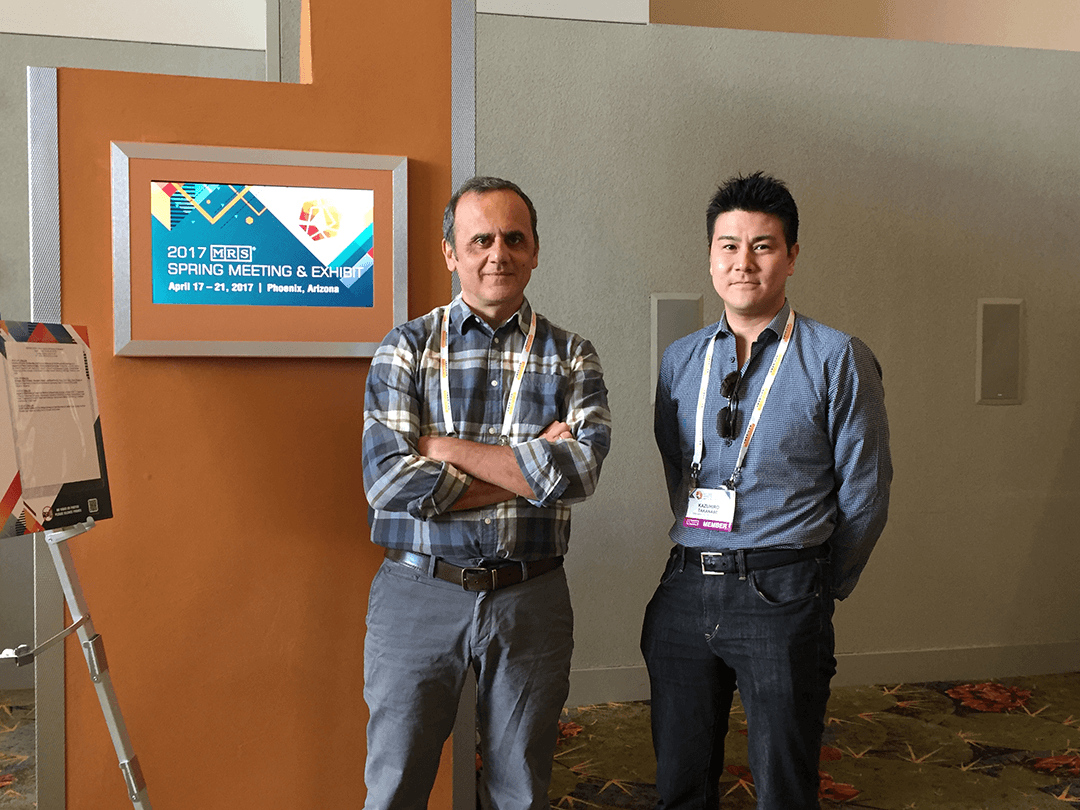
KAUST Professors Luigi Cavallo (left) and Kazuhiro Takanabe attended the MRS Spring 2017 Meeting & Exhibit in Phoenix, Arizona, to give talks covering their research areas. Photo by Caitlin Clark.
"KAUST should be actively involved in organizing more symposiums and advertising the University as one of the fastest-growing research universities at other upcoming MRS meetings," added Han.
"I hope to participate once more in the 2017 MRS Fall Meeting & Exhibit, which would be the last of my Ph.D. student career," Munir said. "Because of the diverse learning opportunities, workshops and discussions, the conferences are always valuable for student life. At the MRS conferences, we learn more, represent KAUST and get to meet the pioneers of materials science. All of these experiences enable us—and KAUST—to excel in research."
"Conferences like the Spring and Fall MRS events put us on the map for scientific activity and bring us abreast with the latest trends. In those respects, the Spring 2017 event was a great success," Kirmani said.
Related stories:
- By Caitlin Clark, KAUST News

